Keywords
|
| Embedded cost, transactions, deregulation, Bilateral Transaction, Matlab, Load Flow |
INTRODUCTION
|
| In the deregulated power sector ‘correct’ pricing of transmission services is useful in providing economic signals for efficient short-run operations, recovery of costs, long-term capital investments and fair allocation of costs among participants. In deregulated power sector there are overall power system is restructured in three main parts, they are generation, transmission and distribution. Electricity price is mainly depend on the transmission system and this is free from generation and distribution. In deregulation environment there are many method for calculation of embedded cost. |
| Electricity markets with different model have been developed in many countries all over the world. This paper briefly reviews the pricing mechanism used by power market in the world. In this comparative analysis has been studied to compare the various pricing methods and effectiveness. |
PURPOSES OF PRICING
|
| All industries re-structuring plans, regardless of the jurisdiction, envision only one transmission system run “for the public benefit” as a type of monopoly franchise. Therefore, government regulation will set the tariff (prices), which means that transmission tariff structure, and the way it is determined and applied are elements of policy[1]. In general, policy makers and their advisers, i.e., economists, engineers, utility executives, consumer advocates, see pricing/cost allocation as having three goals: |
| ïÃâ÷ Recovery cost |
| ïÃâ÷ Encourage efficient use |
| ïÃâ÷ Encourage efficient investment |
| Recovery costs- Fees for transmission use must produce revenue to cover all the expenses of investment, operation, and maintenance, as well as provide a small, (regulated) level of profit for the owners. |
| Encourage efficient use- The price structure (relative cost as a function of the service sought, |
| e.g., amount of power transported, distance, etc. should give incentives for using the transmission system efficiently. The meaning of efficiency is the subject of much disagreement, but everyone agrees pricing should encourage it[2]. |
| Encourage efficient investment- The price structure and the way money is paid to owner should provide an incentive for investment in new facilities where they are needed. |
| In addition, some requirements can be defined for a pricing system, based on practical stipulations of the ISO and its customers. A pricing system must be: |
| Fair – Exactly what is fair and what isn’t might be debatable, but most people will agree that any pricing system must be fair or equitable to all user. |
| Understandable – Any pricing system must be understandable to its customers. If a pricing mechanism is so complex that its users do not trust their ability to make good buying decisions, they will not use the product and will seek other ways to satisfy their needs. |
| Workable – A pricing system so complicated that it cannots be implemented economically is impractical. Many seemingly good ideas in pricing required measurement of power flow at so many points, and system analysis so detailed, that it is questionable if they can be implemented successfully, and it is doubtful that their cost is justifiable. |
AUCTION MECHANISM
|
| In decentralized electricity markets, auction mechanisms are the easiest, efficient and most transparent way to compute the market clearing price. An auction operates under an explicit set of rules adhered to by all of the players that determine resource allocations and prices based upon the bids. |
| The single-side auction is used for pricing where one of the parties offering to sell (buy) a resource is willing to receive (pay) a specified amount. Each Genco submit a bid, which is an ordered pair (p@q) representing a price , p, and quantity, q. These bids are stored in ascending order by price. |
| They are then accepted sequentially , adding the quantity of each bid to a running total until this total meets the demand. At this point no more bids are accepted, and the last one is accepted for only the amount of remaining demand[3]. |
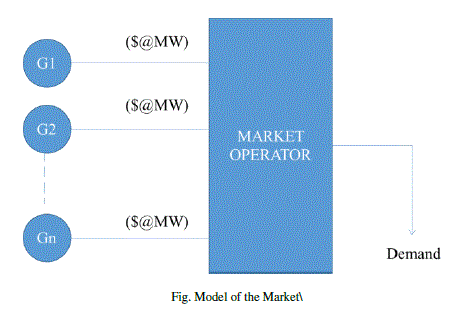 |
OVERVIEW OF EMBEDDED COST METHODS
|
| Postage stamp rate: Every transmission customer pays a single rate for any transmission transaction within a defined region, regardless of the contractual origin and contractual destination of the electricity transmitted. That rate is the same rate for every customer[4]. The rate is an “average rate” because the total costs of the region's transmission network are divided by the total units transmitted, resulting in an average cost per unit “A postage stamp rate means that every customer pays the same averagerate regardless of whether the cost caused or benefit derived by thatcustomer from a given transaction varies from the average.” |
 |
| where |
| Pw = Transacted power |
| C = Annual fixed cost |
| Ppeak = Peak load of the system |
| Contract path method: This method is based upon the assumption that the power due to transaction is confined to flow along a specified electrically continuous path through the transmission system. |
| This method is easy to implement, but the embedded capital cost of those facilities which lies along the assume path is only taken into consideration. Moreover neither reverse flows or parallel flows are considered[5]. |
 |
| where |
| Pw = Transacted power |
| C = Annual fixed cost |
| P_(min. path) = minimum power path |
| Boundry Flow Method: Boundry Flow (BF) Method is used for calculating the change for transmission transaction across the border of a grid. Boundry Flow method is useful when more then one transmission company is involved transaction. Moreover the distance wheeled is not taken into account in this method. |
| Equivalent Bilateral Exchange method: This method is on the principle of equivalent bilateral exchanges, which states that after all physical law governing the flow of power have been met, each demand is assigned a fraction of each generation and each generator is assigned a fraction of each demand in a uniform manner. Transmission cost allocation based on this principle present several advantages, namely, independence from the choice of the slack bus, recognition of counter-flows, and transmission use charge that are stable and always positive. |
| MW-mile method: According to MW-mile method, embedded cost of transmission system are allocated proportionally to the change in the line MW flows caused by the transmission transaction and length of the line in miles. This method is also called line-by-line method. This method is possibly the fairest among all the above methods. However it requires lot of computations, in particular for large number of simultaneous transactions. Moreover reactive power is not considered in this method. |
 |
| where |
 |
| MVA-mile method : In all the above methods reactive power change in the transmission facilities caused by transaction party are not considered. MVA-mile method can take into consideration both active and reactive power loading of the transmission network caused by the transaction and hence allocates ambedded cost of transmission accordingly. Hence a transaction causing more reactive power loading will be allocated more cost than other transaction. |
 |
 |
| MW-cost Method: According to proposed MW-cost method, embedded costs of transmission system are allocated proportionally to the change in MW flows of each facility caused by the transmission transaction and cost of that facility. |
 |
 |
| MVA-cost method: It has been recognized that the use of transmission resources is best measured by monitoring both real and reactive power. This proposed MVA-cost method can take into consideration both active and reactive power loading of the transmission network caused by the transaction and hence allocates ambedded cost of accordingly. |
 |
 |
CALCULATION FOR IEEE 9 BUS SYSTEM AND RESULTS
|
| The method of allocation of embedded cost have been analyzed on IEEE 9 Bus system. The system has been modified, in order to include different transaction. It is assumed that each system generator is an independent generating company (genco)[6]. Allgenerating companies (genco) are supplying power to retailers or load centers at different buses through a power pool. In addition to this, two simultaneous bilateral transactions as given in table1 and shown in fig.1 are added to this system[7]. |
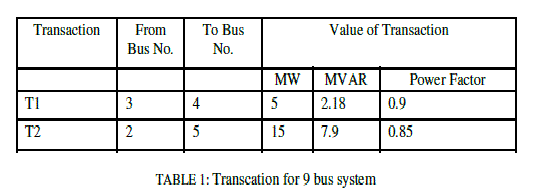 |
| For the given IEEE 9 Bus system Annual Fixed Charge Rate (AFCR) isassmed 15% and the calculation is based on this data. |
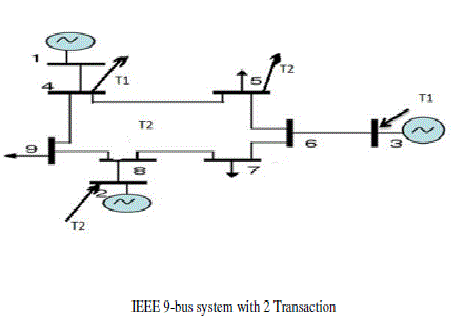 |
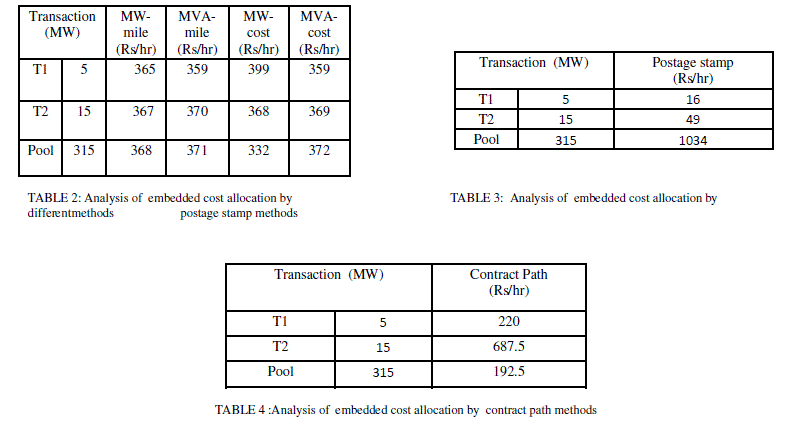 |
CALCULATION FOR IEEE 30 BUS SYSTEM AND RESULTS
|
| Now we take IEEE 30 Bus system. In addition to this, three simultaneous bilateral transactions in MW and MVA are as given in table1 and shown in fig.1 are added to this system and power factor of the system is assumed. |
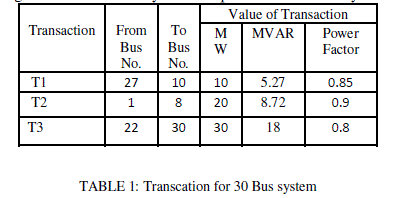 |
| For the given IEEE 30 Bus system Annual Fixed Charge Rate (AFCR) isassmed 15% and the calculation is based on this data. In this system we take 20 retailers or load centers at different buses through a power pool. In addition to this, three simultaneous bilateral transactions as given in table1 and shown in fig.2 are added to this system[10,11]. |
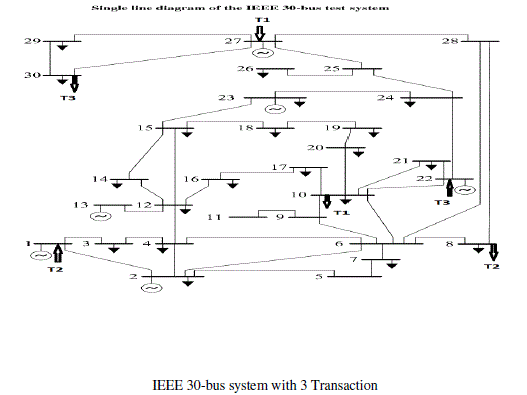 |
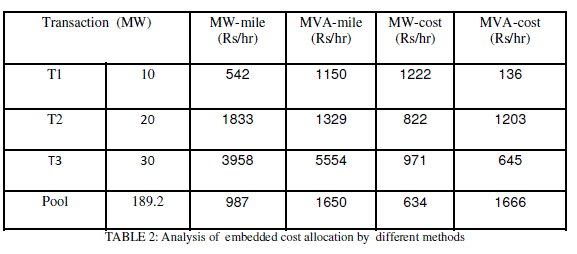 |
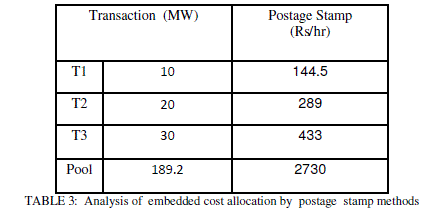 |
CONCLUSION
|
| The methods for allocating transmission system cost to simultaneous transaction and pool participant have been analysed. The results of MW-cost and MVA-cost method have been compared with the best conventional methods. From the analysis it is very much clear that MW-cost and MVA-cost method is fairest among all the existing methods as it is able to overcome all drawbacks of existing methods[16] It can be accurately and conveniently applied under all circumstances to a morden deregulated power system. |
| |
References
|
- Muchayi, M. ; El-Hawary, M.E.; “A method for optimal pricing of electric supply including transmission system considerations”, IEEE Conference on Electrical and Computer Engineering, 1997 , Publication Year: 1997 , Page(s): 293 - 296 vol.1
- Sood, Y.R. ; Padhy, N.P. ; Gupta, H.O.;“A new method for allocating embedded cost oftransmission under deregulated environment ofpower system, Power Engineering Society GeneralMeeting, 2006. IEEE
- XiaokangXu ; Lane, D.W. ; Edmonds, M.J.S.; “A simulation tool for calculating energy prices in competitive electricity markets , Conferenceon Electric Utility Deregulation and Restructuring and Power Technologies, DRPT 2008 , Publication Year: 2008 , Page(s): 7 - 11
- Tehzeb-ul-Hassan ;Haral, A. ; Aslam, M.F. ; “Analysis of Spot Prices Arrangements in Deregulated Electricity Market”, InternationalConference on Electrical Engineering, 2007. ICEE '07.,Publication Year: 2007 , Page(s): 1 – 6
- Leevongwat, I. ;Rastgoufard, P. ; “Forecasting Locational Marginal Pricing inderegulated power markets ”, Power Systems Conference andExposition, 2009. PSCE '09. IEEE/PES , Publication Year: 2009 , Page(s): 1 - 9
- de la Cruz-Soto, J. ; Gutierrez-Alcaraz, G. ; “Electricity Market Prices: An Indicator of MarketPower?”, International conference on IntelligentSystem Applications to Power Systems, 2009. ISAP '09, Publication Year: 2009 , Page(s): 1 – 8
- Xing Yan ;Chowdhury, N.A. ; “Electricity market clearing price forecasting in aderegulated electricity market”, 11th International Conference onProbabilistic Methods Applied to Power Systems (PMAPS), 2010 IEEE, Publication Year: 2010, Page(s): 36 - 41
- Pany, P.K. ;Ghosal, S.P. ; “Intelligent systems for dynamic price forecasting in a competitive electricity market”,International conference onIndustrial Electronics, Control & Robotics (IECR), 2010, Publication Year: 2010 , Page(s): 257 – 260
- Pinto, T. ; Sousa, T.M. ; Vale, Z.; “Dynamic artificial neural network for electricity market prices forecast”, 16th International conference onIntelligent Engineering Systems (INES), 2012 IEEE, Publication Year: 2012, Page(s): 311 – 316
- Chakrabarti, B.B.; Goodwin, D.G. ; “Monitoring and Measuring Market Power in the New Zealand Electricity Market”, Joint internationalconference on Power System Technology and IEEE Power India Conference, 2008. POWERCON 2008, Publication Year: 2008 , Page(s): 1 - 8
- Mazengia, D.H. ; Tuan, L.A. ; “Forecasting spot electricity market prices using time series models”, IEEE International conference onSustainable Energy Technologies, 2008. ICSET 2008, Publication Year:2008, Page(s): 1256 – 1261
- Murali, M. ;Kumari, M.S. ; Sydulu, M. “A comparison of embedded cost based transmission pricing methods” 2011 International Conferenceon Energy, Automation, and Signal (ICEAS), Publication Year: 2011 , Page(s): 1 – 6
- Lima, D.M. ; Americano da Costa, M.V. ; Normey-Rico, J.E., “A flexible low cost embedded system for Model Predictive Control of industrialprocesses” 2013 European Control Conference (ECC), Publication Year: 2013 , Page(s): 1571 – 1576
- Drumea, A. ;Svasta, P., “Designing low cost embedded systems with ethernet connectivity” 2011 IEEE 17th International Symposium forDesign and Technology in Electronic Packaging (SIITME),Publication Year: 2011 , Page(s): 217 - 220
- Siddiqui, Z.A. ; Munir, A. ; Sherazi, M.F. ; Danish, S.M., “Design of low cost embedded system for automation of a parallel processing plant”2011 International Conference on Advanced Mechatronic Systems (ICAMechS),Publication Year: 2011 , Page(s): 362 – 366
- WeihaoHu ;Zhe Chen ; Bak-Jensen, B., “Impact of optimal load response to real-time electricity price on power system constraints inDenmark” , 2010 45th International Universities Power Engineering Conference (UPEC), Publication Year: 2010 , Page(s): 1 - 6
- Morrow, I. ; Bunn, D., “Price formation and market power in a low carbon electricity system”2011 8th International Conference on the European Energy Market (EEM), Publication Year: 2011 , Page(s): 839 – 843
|